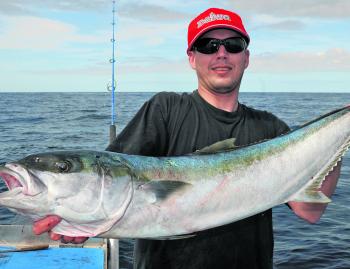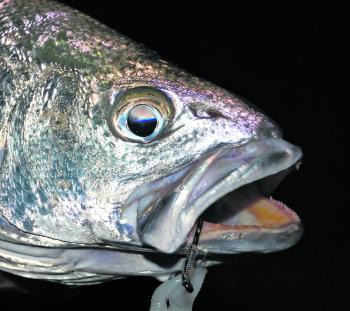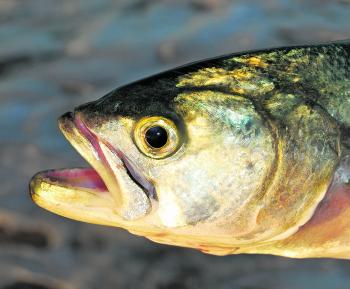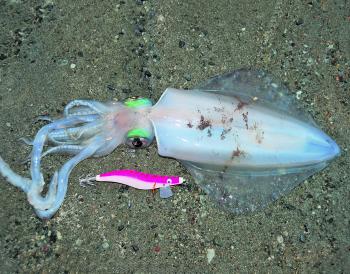During the summer months and into early autumn larger oceanic predators like marlin, Spanish mackerel and sharks move down the east coast, often close to shore. Plenty of smaller pelagic fish including bonito, kingfish and mac tuna also invade inshore waters during this period.
However, the action doesn’t stop or fade away just because the days are getting shorter and cooler. In fact, the weeks leading up to winter are when some of the biggest fish move in close, particularly along our coastal rocks, beaches and headlands. This is a good opportunity for shore based, small boat and kayak anglers to take advantage of the fishing on offer.
While some of those traditional summer gamefish like marlin are still well and truly possible a bit further offshore, the more common predators that move in close at this time of year are mulloway, kingfish, cobia, Spanish mackerel and tailor. May is the month when the very biggest of these fish are often caught and many anglers have scored their personal best specimens at this time.
One of the main factors that spurs this on is the abundance of larger prey items that take up residence in sheltered bays adjacent to major headlands, river mouths and at the end of long surf beaches. Mullet, tailor, garfish and calamari squid may be present in such areas year round, but right now they are bigger and in greater numbers than any other month.
Many experienced mulloway specialists would probably agree that April and May are the prime months for pinning a big one from the rocks or beaches along most of the NSW coastline. Although, north of Port Macquarie the run of big fish often runs later, into July or even August, depending on the season. From Port Stephens, along the Central Coast and down to past the Illawarra though, May is the peak month for mulloway over 20kg.
Bays, small beaches, headlands, inshore bommies and river mouths are the places to look for big mulloway, as well as any good gutters along open surf beaches. One of the key points when working out exactly where to try your luck is to look for a good amount of whitewash spilling over a deeper hole or gutter. This provides both prey and predator some form of cover where the bait may feel safer, but the predator can hide and ambush more effectively.
The real danger period for hapless mullet, smaller tailor, calamari and so on is just as darkness falls or the hour before sunrise in the morning. This is the very best time to get out there armed with some sturdy tackle that will handle big fish.
Tide changes are also important in some spots. Along open surf beaches the hour leading up to and particularly right on the high tide change is a crucial period to have a bait in the water. Around river mouths a high or low tide change can be good, although the very first of the run out is another danger period for mullet or other potential food items. If there’s a bit of discoloured water coming out of the river so much the better.
Of course, it makes sense to match the bait with food that is naturally occurring in the area. This means live mullet, tailor, pike or yakkas, fresh fillets of the same fish, mullet or tailor heads, calamari and beach worms. It’s vital that any of these baits be caught rather than purchased, so be prepared to set aside plenty of time to secure good bait.
Along with numbers of smaller to average tailor, the bigger models, often called ‘greenbacks’ are also on the prowl, with a taste for mullet, garfish and even their smaller kin, as tailor certainly are cannibalistic!
Solid 2kg tailor are reasonably common, but some spots also attract a better class of fish up to 5kg or more. A 30cm mullet or extra-large garfish makes a very appealing meal for these bigger tailor and they’re a more efficient predator than mulloway, being faster in the water, with a big mouth full of razor sharp teeth.
So this means using a wire trace could be a good idea in some cases, especially when casting expensive lures. Just prior to writing this article, I spent a few hours enjoying a very intense session lure casting for tailor, and three lures were bitten off. Most of the time, a larger lure and leader of 15kg mono or fluorocarbon is enough insurance against bite offs, but a big tailor has no problem engulfing a 15cm lure.
Like many other species, as tailor grow older they also become a bit harder to fool. So if scoring a big specimen is your goal, one trick well worth trying is livebaiting with a whole mullet, pike or average size tailor, using a short length of nylon-coated or single-strand wire and one or two 8/0 hooks pinned through the back of the livie.
Another option is a large whole garfish, small pike or decent size strip of mullet, tailor, pike or bonito fillet on a set of 5/0 or 6/0 ganged hooks and a short wire trace. Alternatively, casting bigger poppers around 15cm is another, quite exciting way of attracting the attention of a big tailor.
As is the case when chasing mulloway, the prime time for big tailor is just after sunset or prior to sunrise. If the morning is quite overcast then the peak feeding time is extended.
The main problem with bigger kings is actually landing them, so the very first priority is to be armed with heavy-duty tackle. Overhead, threadline or sidecast reels all work, as long as they hold enough line and are built to deal with big fish. As for the line, 15kg braid or mono is a start, but 20-24kg line is better. A fluorocarbon or mono leader of 20-40kg should be employed and this is a must when using braid. Drags need to be tightened up and your arms ready for a stretching!
Without question, the most irresistible baits for these larger inshore kings are live calamari, live pike and live garfish, with the calamari out in front. Closely behind these baits are live yakkas, live mullet, slimy mackerel and a whole salted garfish pinned to a set of 6/0 ganged hooks. If any of these baits are hard to come by, try fresh strips of calamari or any live fish that you can catch and that means bream, drummer, mados or sweep making sure, of course, they are of legal size. I’ve definitely caught a number of kingfish on live mados over the years.
Although sunrise and sunset are good for any inshore predators, when chasing kings this isn’t as crucial as it is with mulloway or tailor. In fact, kingfish will take a bait at any time of day if it’s something they want to eat and it’s presented in their vicinity.
Spanish mackerel, cobia and longtail tuna are the big three northern visitors that occasionally show up south of Sydney, but are much more common along the mid north coast between Port Stephens and Coffs Harbour at this time of year. Prominent points like Tomaree at Port Stephens, Korogoro at Hat Head and Perpendicular near Laurieton are well known haunts for shore-based anglers, but there are numerous points, bommies and inshore reefs that attract these big fish annually.
Once again, sturdy tackle is a must, but it’s not as important to have the reel spooled up with heavy line as it is when targeting kingfish. More line should be packed onto the spool though, as a big mackerel can seriously rip out 100m of line in a single run. A decent longtail is no slouch either, while a solid cobia will always be a handful to deal with.
In some places it’s not always possible to target each of these fish separately, as they’ll all take a live garfish, pike or tailor and they can frequent the same spots. However, Spanish are definitely more common from South West Rocks to Yamba, so at least anglers fishing to the south are unlikely to need wire at the end of the line.
Cobia are also a bit more inclined to take baits deeper down towards the bottom near small patches of reef with surrounding sand. Once again though, it’s certainly not out of the question to hook all three species in the one session.
So don’t pack that heavy tackle away just yet, as things are only heating up!
Reads: 3070
If catching a solid inshore kingfish is your goal then May is the month to put in the effort. Live calamari squid or live garfish are right at the top of the list for kingy baits.

Mulloway patrol the surf beaches and semi protected bays at this time of year, as they follow the annual mullet run.

Some of the biggest tailor can be expected this month. They may turn up anywhere, but washy inshore reef and bommies adjacent to sheltered bays are potential hot spots.

Mullet are an abundant food source that attract big inshore predators this month. Wherever mullet gather in numbers you can be sure those predators won’t be far away.

This is also a prime time of year for big calamari squid and they make first class bait for big kings and mulloway. So it’s well worth spending some time gathering bait like this.

Smaller protected beaches like this are safe havens for mullet and garfish. Unfortunately for them, predators are well aware of their presence!

Hooked up to a rampaging inshore king on the mid north coast. Unfortunately the beast won its freedom on this occasion.




